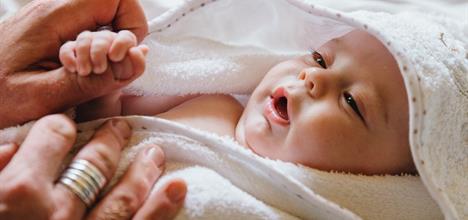How Much Does Usually Hospital Charge for the Newborn Baby
Ages & Stages
Bathing Your Baby


Page Content
By: Dipesh Navsaria, MPH, MSLIS, Doc, FAAP
Bathing your infant is an experience many parents treasure. Information technology's a great time to bond, distraction-complimentary, as your tiny new family unit fellow member enjoys the awareness of warm water on their pare. Notwithstanding this common parenting ritual oft comes with questions, and sometimes anxiety, almost when and how to practice it well.
Hither are some frequently asked questions from parents about topics related to baby bathroom timing, frequency, rubber, and more than.
When should newborns get their start bathroom?
The timing of your baby's very starting time bath has changed over the last few years. While most institutions used to bathe babies inside an hour or ii of birth, many are changing their policies.
The World Health Organisation (WHO) recommends delaying baby'south start bathroom until 24 hours later birth—or waiting at to the lowest degree 6 hours if a full day isn't possible for cultural reasons.
Why wait? |
|---|
Notation: Babies of mothers with HIV or the Hepatitis viruses will still be bathed after the initial breastfeed in guild to decrease risk to hospital staff and family members.
How often do babies need a bath once they are dwelling?
Newborns don't need a bath every day. They rarely sweat or get dirty plenty to need a full bath that often.
Three baths per week during baby's showtime year may be enough. Bathing more than frequently can dry out your baby'due south skin.
Can my babe have a bath before the umbilical cord falls off?
Only give your newborn sponge baths until the stump of the umbilical cord falls off, which normally happens by about one or two weeks of age. If information technology remains beyond that time, there may be other bug at play. See the baby's doctor if the string has non dried upward and fallen off past the time the baby is two months old. Learn more here.
How to give a sponge bathroom
A sponge bath is like a regular bath, except you don't put your babe in the water.
Baby sponge bathroom safety tips:
|
|---|
When is my infant ready for a regular bath?
Once the umbilical area is healed, you can try placing your baby directly in the water. His first baths should be every bit gentle and brief as possible. He may protest a piddling. (If this happens become dorsum to sponge baths for a calendar week or 2, then try the bath again). Babies unremarkably get in articulate when they're set up.
Baby bathtub safety tips:
|
|---|
Call up…
Knowing the nuts can brand bathing your infant a breeze. Only make certain your baby stays comfy and safety during bath time―and don't forget to soak up all the special moments that come up with it!
Additional Information:
-
Babe Water Safety: Protect Your New Baby from Drowning
-
5 Bathroom Safe Tips for Infants & Young Children
-
Baby Birthmarks & Rashes
Almost Dr. Navsaria:
 Dipesh Navsaria, MPH, MSLIS, MD, FAAP is an associate professor of pediatrics at the University of Wisconsin School of Medicine and Public Health and is director of the Doctor–MPH program there. He has practiced primary intendance pediatrics in a diversity of settings and is the founding medical director of Reach Out and Read Wisconsin. Dr. Navsaria regularly writes op-eds on wellness-related topics, does radio and television interviews, and frequently speaks locally, regionally and nationally on early encephalon and kid development, early on literacy, and advocacy to a broad variety of audiences. Follow him on Twitter @navsaria, Facebook, and visit his website www.navsaria.com.
Dipesh Navsaria, MPH, MSLIS, MD, FAAP is an associate professor of pediatrics at the University of Wisconsin School of Medicine and Public Health and is director of the Doctor–MPH program there. He has practiced primary intendance pediatrics in a diversity of settings and is the founding medical director of Reach Out and Read Wisconsin. Dr. Navsaria regularly writes op-eds on wellness-related topics, does radio and television interviews, and frequently speaks locally, regionally and nationally on early encephalon and kid development, early on literacy, and advocacy to a broad variety of audiences. Follow him on Twitter @navsaria, Facebook, and visit his website www.navsaria.com.
Article Trunk
- Last Updated
- three/3/2020
- Source
- American Academy of Pediatrics (Copyright © 2019)
The information contained on this Spider web site should not exist used equally a substitute for the medical intendance and communication of your pediatrician. There may be variations in treatment that your pediatrician may recommend based on individual facts and circumstances.
Source: https://healthychildren.org/English/ages-stages/baby/bathing-skin-care/Pages/Bathing-Your-Newborn.aspx
0 Response to "How Much Does Usually Hospital Charge for the Newborn Baby"
Postar um comentário